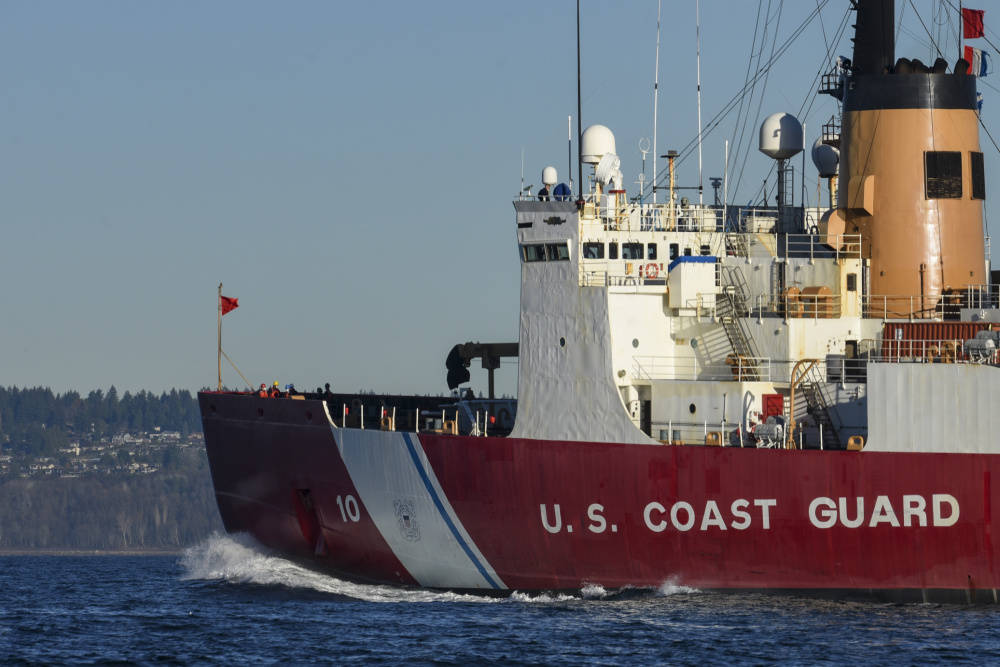President Donald Trump’s decision to veto the annual defense budget may have lasting effects for Alaska, especially the Coast Guard.
The National Defense Authorization Act, which included more than $740 billion for military programs and construction, was combined with the Coast Guard’s annual funding authorization for the first time, a move he helped engineer, said Sen. Dan Sullivan, a Republican, in a news conference.
The NDAA included funding for construction of a second Polar Security Cutter, the Coast Guard’s new heavy icebreaker class, as well as funding for new National Security Cutters and Fast Response Cutters, some of which will be homeported in Alaska.
[Sullivan announces intent to override Trump’s defense budget veto]
But is that funding enough? Sullivan argued that more emphasis should be placed on Alaska.
“Coast Guard infrastructure, even in Kodiak, can’t currently support medium and heavy icebreakers. There’s a requirement related to how big and heavy these ships are,” Sullivan said. “The Coast Guard needs to work with us to facilitate the ability on Coast Guard bases (in Alaska) to homeport these icebreakers.”
More and bigger
Sullivan said he was working hard to ensure as much new construction as possible was sent to Alaska, which needs it to support a growing mission in the far north. The Coast Guard has only one heavy icebreaker, the Polar Star, which is currently deployed in the Arctic, a retasking from its annual mission to support McMurdo Station in Antarctica.
A second medium icebreaker, the Healy, is in the yards with an engineering casualty and is not seaworthy. Neighboring nations, including the non-Arctic China, have more and bigger icebreakers, including Russia’s recently launched nuclear-power Arktika.
“The men and women of the Coast Guard are rescuing lives every day, especially in our state. But their strategic outlook is a little myopic,” Sullivan said. “Our icebreakers need to be homeported in the Arctic. Most people don’t know they take 8-9 days to transit to the Bering Strait from Seattle.”
The initial homeport for the icebreakers will be in Seattle, Sullivan said, but he’s advocating for the expansion of facilities in Alaska. A survey is currently being done of Alaskan communities for port cities with the Coast Guard and non-Coast Guard infrastructure required to support the vessels.
“The heavies, once built, will be homeported in Seattle. But it makes sense to keep the other icebreakers in Alaska,” Sullivan said. “Where the hell else are you going to put them? Florida? Although I guess that’s where one of them is.”
The icebreaker in Florida is identified by The Associated Press as the Aiviq, a civilian medium icebreaker owned by Gary Chouest, a major donor to the Republican party, and forwarded by Sullivan as a candidate for leasing by the government. Sullivan also mentioned a possible icebreaker in Finland for use.
Contested waters
That mission for the nascent icebreaker fleet is only growing more important as incursion by Russian and Chinese forces and fishing fleets in American waters and exclusive economic zones.
“There was a huge discussion on what happened when our fishing fleet had these huge problems and were not made aware of this gigantic Russian navy, army and air force operation in our exclusive economic zone,” Sullivan said. “I think there’s a huge number of missions that Polar Security Cutters have with regard to protecting to economic interests, fishing interests, environmental interests, and national security interests in the United States Arctic (territory).”
Sullivan measured leasing medium icebreakers as a stopgap measure while the PSCs come out of the yards and enter active commission.
“How do we bridge the gap, now that the Healy is down for overhaul? We’re essentially down to one icebreaker,” Sullivan said. “The big play right now is to try to execute a leasing option with two medium class icebreakers, like, within the next several weeks. There’s money in the Navy’s budget for this. And to try to get these homeported in the interim in Alaska.”
Sullivan also discussed an ongoing project to build a deepwater port near Nome, supporting operations in the high Arctic.
• Contact reporter Michael S. Lockett at 757-621-1197 or mlockett@juneauempire.com.

